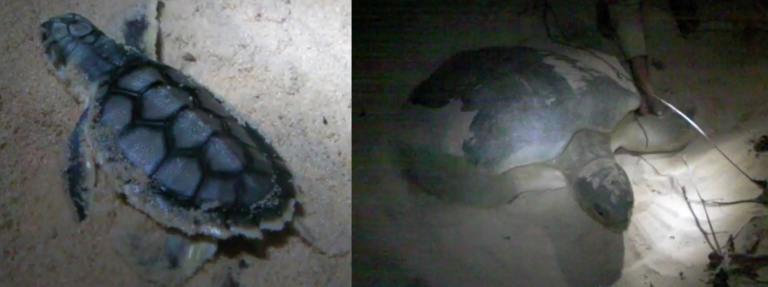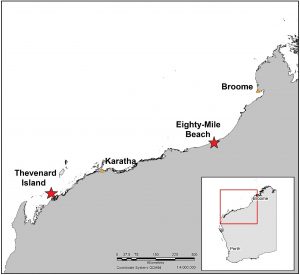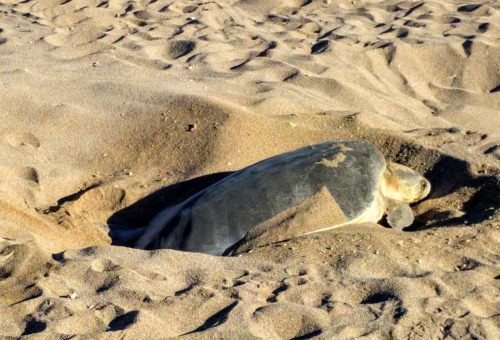Figure 1 – Flatback sea turtle nesting in Thevenard Island. Carapace and skin samples were collected after females nested, when they were on their way back to the ocean.
Researchers from the ANU and the Department of Biodiversity, Conservation and Attractions of Western Australia to perform the first assessment of mercury concentrations in flatback turtles (Natator depressus) from mining and non-mining sites of Western Australia
The mining sector is one of the main sources of mercury to the environment in Australia. The mercury released into the environment eventually enters the open ocean and becomes available to aquatic organisms to bioaccumulate and biomagnify up through food chains.
Because it is a persistent substance, mercury can bioaccumulate and biomagnify up through food chains, resulting in increasing levels on higher order species, such as omnivorous and carnivorous sea turtles. Understanding the mercury bioaccumulation patterns in marine organisms is, therefore, crucial and necessary to protect them from the toxic effects of this element.
The flatback turtle (Natator depressus) is unique among the seven species of sea-turtles in the world in that it does not have a pan-oceanic distribution, being reported to be endemic to the Australian continental shelf. Flatback turtles are the least studied sea turtle species and have consequently been categorised ‘data deficient’ (IUCN).

Figure 2 – Flatback sea turtle (Natator depressus) mother (left) and hatchling (right) at Gundargarl Island in the Northern Territory. Photos by Nicholas Metherall.
Past studies of the flatback turtle suggest the species to be carnivorous feeding on soft-bodied invertebrates including soft corals, sea cucumbers, jellyfish, and sea pens. As a carnivorous species, mercury concentrations in this species are expected to be high.
Sea turtles are prominent members of oceanic food web and have life history characteristics that make them vulnerable to mercury accumulation (e.g., long life span, high trophic level, aquatic habitat). The Flatback is the least studied species among all sea turtles, with only one study available on heavy metals in blood and eggs of this species. The lack of data for this species resulted in the flatback turtle (Natator depressus) being listed as “data deficient” in the IUCN Red List of Threatened Species.
ANU and DBCA researchers sampled two populations of the Flatback turtles of Western Australia, Thevenard Island and Eighty-Mile Beach (Figure 1), to assess mercury levels. Researchers are checking if mining activities are causing an increase in mercury bioaccumulation by these turtles. Ultimately, the researchers are establishing a baseline of mercury concentration to compare against contaminated turtles in the future.

Figure 3 – Thevenard Island and Eighty Mile Beach, in Western Australia. Flatback populations (Natator depressus) of these two sites were sampled for mercury analyses and assessment.
Natator depressus are interconnected to the food web both as predators of soft-bodied invertebrates as well as highly vulnerable to a range of predators. As a result, an understanding of mercury levels in flatback turtles can also serve as a bio-indicator of the levels of mercury bioaccumulated and biomagnified within wider food chains.
Flatback turtles are also vulnerable to diseases, barnacles, climate variability and other risks. Survivorship from hatchling emergence to maturity has been estimated to be less than 0.0026 (Parmenter and Limpus, 1995).
Currently, researchers are working on the mercury analyses found in Natator depressus. The published results will better inform regulators and risk management authorities of the status and risks of mercury contamination in flatback turtles. This research has the potential to help conserve these highly vulnerable species as well as wider biodiversity throughout the food-chain.
Article by Dr Larissa Schneider.


Twitter